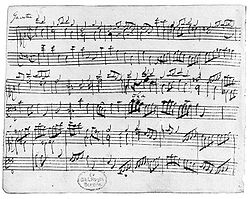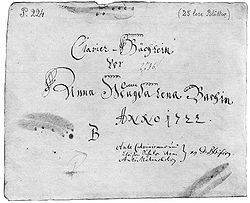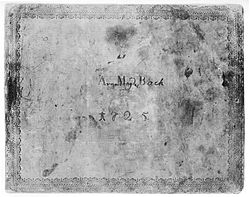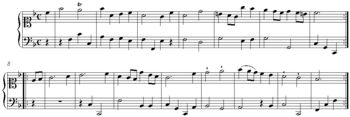- Notebook for Anna Magdalena Bach
-
The title Notebook for Anna Magdalena Bach refers to either of two manuscript notebooks that the German Baroque composer Johann Sebastian Bach presented to his second wife Anna Magdalena. Keyboard music (minuets, rondeaux, polonaises, chorales, sonatas, preludes, musettes, marches, gavottes) makes up most of both notebooks, and a few pieces for voice (songs, and arias) are included.
The two notebooks are known by their title page dates of 1722 and 1725. The title "Anna Magdalena notebook" is commonly used to refer to the latter. The primary difference between the two collections is that the 1722 notebook contains works only by Johann Sebastian Bach (including most of the French Suites), while the 1725 notebook is a compilation of music by both Bach and other composers of the era. It provides a nearly unparalleled glimpse into the domestic music of the 18th century and the musical tastes of the Bach family.
Contents
The 1722 notebook: French Suites and miscellany
This notebook contains 25 unbound sheets (including two blank pages), which is estimated to be approximately a third of the original size. It is not known what happened to the other pages. The back and the corners are decorated with brown leather; greenish paper is used for the cover. The title page is inscribed Clavier-Büchlein vor Anna Magdalena Bachin ANNO 1722 in Anna Magdalena's hand. For a reason so far unknown to researchers, Johann Sebastian wrote the titles of three books by theologian August Pfeiffer (died 1698) in the lower right corner of the title page:
- "Ante Calvinismus" is a shortened and misspelled title of Anti-Calvinismus, oder Unterredungen von der Reformierten Religion (literally "Anti-Calvinism, or Conversations about the reformed religion").
- "Christen Schule item" refers to Pfeiffer's Evangelische Christen Schule ("Evangelical Christian School").
- "AntiMelancholicus" refers to Anti-melancholicus, oder Melancholey-Vertreiber (literally "Anti-melancholy, or [something or someone used to drive out the melancholy]").
The notebook contains the following works, most in Johann Sebastian's hand:
- Five keyboard suites. The first three are fragments of the pieces that are now known as the first three French Suites, BWV 812–814. The next two are complete suites, French Suites Nos. 4 and 5, BWV 815–816. The minuets of suites 2 and 3 are separated from the rest of their respective suites and were most probably added at a later date by Anna Magdalena Bach (they are almost certainly in her hand), some time before 1725.
- Fantasia pro organo, unfinished, BWV 573. A short organ piece, 12 complete bars and the beginning notes of the 13th bar.
- Air with variations in C minor, unfinished, BWV 991. The first 10 bars feature coherent two-part writing, but the remaining 35 bars only have one voice written out.
- “Jesus, meine Zuversicht”, chorale prelude, BWV 728. A brief (9 bars) piece in three voices, features two sections with repeats for each.
- “Minuet in G major”, BWV 841 (not to be confused with Petzold's Minuet in G Major in the 1725 notebook). A short dance with simplistic two-part writing and two sections with repeats for each.
The 1725 notebook
The 1725 notebook is bigger than the 1722 one, and more richly decorated. Light green paper is used for the front cover, Anna Magdalena's initials and the year number "1725" are printed in gold. All pages feature gilt edging. Most of the entries in the 1725 notebook were made by Anna Magdalena herself, with others written in the hand of Johann Sebastian, some by sons Johann Christian and Carl Philipp Emanuel, and a few by family friends such as Johann Gottfried Bernhard and Johann Gottfried Heinrich. Although the 1725 notebook does contain work composed by Johann Sebastian Bach, it also includes works by many other composers. The authorship of several pieces is identified in the notebook itself, while that of others was established by researchers. The composers of still others, including several popular songs of the time, remain unknown. Here is a complete list of the pieces included, in order of appearance in the notebook:
- Keyboard partita in A minor, BWV 827. This is the third partita from Bach's set of Partitas for keyboard BWV 825–830, which was published in 1731 as the first volume of Clavier-Übung.
- Keyboard partita in E minor, BWV 830. This is the sixth partita from Bach's set of Partitas for keyboard BWV 825–830.
- Minuet in F major, BWV Anh. 113.
- Minuet in G major, BWV Anh. 114. Usually attributed to Christian Petzold.[1][2][3]
- Minuet in G minor, BWV Anh. 115. Usually attributed to Christian Petzold.
- Rondeau in B-flat major, BWV Anh. 183. This piece is by François Couperin and is best known under the original title: Les Bergeries.
- Minuet in G major, BWV Anh. 116.
- Polonaise in F major, BWV Anh. 117a.
Polonaise in F major, BWV Anh. 117b. - Minuet in B-flat major, BWV Anh. 118.
- Polonaise in G minor, BWV Anh. 119.
- Chorale prelude “Wer nur den lieben Gott läßt walten”, BWV 691.
- Chorale setting “Gib dich zufrieden und sei stille” in F major, BWV 510.
- Chorale setting “Gib dich zufrieden und sei stille” in D minor, BWV 511.
Chorale setting “Gib dich zufrieden und sei stille” in E minor, BWV 512. - Minuet in A minor, BWV Anh. 120.
- Minuet in C minor, BWV Anh. 121.
- March in D major, BWV Anh. 122. Usually attributed to Carl Philipp Emanuel Bach.
- Polonaise in G minor, BWV Anh. 123. Usually attributed to Carl Philipp Emanuel Bach.
- March in G major, BWV Anh. 124. Usually attributed to Carl Philipp Emanuel Bach.
- Polonaise in G minor, BWV Anh. 125. Usually attributed to Carl Philipp Emanuel Bach.
- Aria “So oft ich meine Tobackspfeife” in D minor, BWV 515.
Aria “So oft ich meine Tobackspfeife” in G minor, BWV 515a. - Menuet fait par Mons. Böhm, by Georg Böhm. Not included in the BWV catalogue.
- Musette in D major, BWV Anh. 126.
- March in E-flat major, BWV Anh. 127.
- (Polonaise) in D minor, BWV Anh. 128.
- Aria “Bist du bei mir”, BWV 508. This composition is probably the most well-known of the arias of the 1725 notebook. Its melody is by Gottfried Heinrich Stölzel.[4]
- Keyboard aria in G major, BWV 988/1. Another well-known piece, this is the aria of the Goldberg Variations, BWV 988. Christoph Wolff has suggested that this Aria was entered into the two blank pages of this book by Anna Magdalena later, in 1740.
- Solo per il cembalo in E-flat major, BWV Anh. 129. A harpsichord piece by Carl Phillip Emanuel Bach.
- Polonaise in G major, BWV Anh. 130. Possibly composed by Johann Adolph Hasse.
- Prelude in C major, BWV 846/1. This is the first prelude from the Well-Tempered Clavier Book 1, with bars 16–20 omitted, most likely in order to make the piece fit in two pages.
- Keyboard suite in D minor, BWV 812. This is the first French Suite.
- Keyboard suite in C minor, BWV 813. This is an incomplete version of the second French Suite.
- Movement in F major, BWV Anh. 131. The handwriting looks like that of a child, and apparently the piece is an attempt to create a bass line for a given melody.
- Aria “Warum betrübst du dich”, BWV 516.
- Recitative “Ich habe genug” and aria “Schlummert ein, ihr matten Augen” (solo), BWV 82/2,3.
- Chorale setting “Schaff's mit mir, Gott”, BWV 514.
- Minuet in D minor, BWV Anh. 132.
- Aria “Wilst du dein Herz mir schenken” (subtitled Aria di Giovannini), BWV 518.
- Aria “Schlummert ein, ihr matten Augen”, unfinished, BWV 82/3.
- Chorale setting “Dir, dir Jehova, will ich singen” (version for choir), BWV 299.
- Chorale setting “Dir, dir Jehova, will ich singen” (solo), BWV 299.
- Song “Wie wohl ist mir, o Freund der Seelen”, BWV 517.
- Aria “Gedenke doch, mein Geist, zurücke”, BWV 509.
- Chorale “O Ewigkeit, du Donnerwort”, BWV 513.
See also
- Klavierbüchlein für Wilhelm Friedemann Bach
- List of songs and arias by Johann Sebastian Bach from the 1725 Notebook for Anna Magdalena (BWV 508-518)
- The 1725 Anna Magdalena Notebook compositions in the Appendix of the BWV catalogue
- Anna Magdalena, a 1998 Hong Kong film titled after the Notebook. Minuet in G is featured extensively throughout the movie
References
- ^ Wolff, Christoph. "Bach. III. 7. Johann Sebastian Bach. Works", Grove Music Online, ed. L. Macy (accessed 21 December 2006), grovemusic.com (subscription access).
- ^ Williams, Peter F.. 2007. J.S. Bach: A Life in Music, p. 158. Cambridge University Press.
- ^ Schulenberg, David. 2006. The Keyboard Music of J.S. Bach, p. 522 and elsewhere.
- ^ Andreas Glöckner in: Bach Jahrbuch 2002, pp. 172-174.
- Bach Gesamtausgabe (BGA), vol. 43/2 [B.W. XLIII(2)]: "Joh. Seb. Bach's Musikstücke in den Notenbüchern der Anna Magdalena Bach" (Johann Sebastian Bach's Music in the Anna Magdalena Bach notebooks). Originally published by the Bach-Gesellschaft.
External links
- Notebook for Anna Magdalena Bach: Free scores at the International Music Score Library Project.
Categories:- Music anthologies
- Compositions by Johann Sebastian Bach
- Compositions by Carl Philipp Emanuel Bach
- Compositions for keyboard
- German manuscripts
Wikimedia Foundation. 2010.





